
Cuneiform TI or TÌL has the main meaning of "life" when used ideographically. The written sign developed from the drawing of an arrow, since the words meaning "arrow" and "life" were pronounced similarly in the Sumerian language.

The cuneiform sign KÁ, for gate is the Sumerogram-(logogram) used in the Amarna letters and the Epic of Gilgamesh; as just KÁ it means "gate" or "doorway", Akkadian language, "bābu"; as "Gate-Great", KÁ.GAL for City-Gate, it is from Akkadian "abullu",. Both uses are in the Epic of Gilgamesh. In the Epic, it is only used as the sumerogram, a total of 19 times,. In the Epic, all spellings for city gate use KÁ.GAL; for gate ('bābu') only one spelling uses the alphabetic letters for b-a-b-u; the rest use KÁ along with other added cuneiform signs.

The cuneiform dan sign is a multi-use sign found in both the 14th century BC Amarna letters and the Epic of Gilgamesh. Besides dan,, the following are its uses :
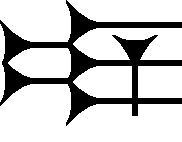
The cuneiform sign for tur is used to denote one syllabic usage, tur, or the sign's Sumerograms; it is used in the Epic of Gilgamesh and the 14th century BC Amarna letters. The sign is based on the i (cuneiform) sign, with the one small added vertical stroke.

The cuneiform ma sign, is found in both the 14th century BC Amarna letters and the Epic of Gilgamesh. In the Epic it is also used as the Sumerogram MA, . The ma sign is often used at the end of words, besides its alphabetic usage inside words as syllabic ma, elsewhere for m, or a.

The cuneiform sign 𒀀 for a, and in the Epic of Gilgamesh the sumerogram A, Akkadian for mû, "water", which is used in the Gilgamesh flood myth, Chapter XI of the Epic, or other passages. The sign is also used extensively in the Amarna letters.

The cuneiform pa sign,, has many uses in both the 14th century BC Amarna letters and the Epic of Gilgamesh. It is routinely and commonly used to spell the Akkadian language word "pānu", face, presence, and with a preposition, before. In the photo of the obverse of EA 364, it is used to spell Akkadian "eperu", 'dust', (EA 364, lines 7,8: "...andand \ dust"-.
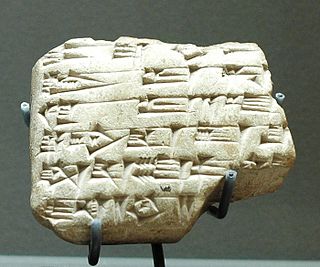
The cuneiform ia sign 𒅀, is a combined sign, containing i (cuneiform) ligatured with a (cuneiform); it has the common meaning in the suffix form -ia, for the meaning of "-mine". In the Amarna letters, the letters written to the Pharaoh of Egypt, the Pharaoh is often referenced as "Lord-mine", or especially: King-Lord-mine: "My King, My Lord". In Akkadian, the form is "Šarru-Bēlu-ia"-(King-Lord-mine), since the spelling in some Amarna letters is sometimes ŠÁR-RI for Šarru,.

The cuneiform DAGAL sign, which is a capital letter (majuscule) Sumerogram with the Akkadian language meaning of to be wide, or extensive; also "many", Akkadian "rapāšu", is a minor usage cuneiform sign used in the Amarna letters and the Epic of Gilgamesh. An equivalent usage sign for DAGAL is used in the Amarna letters, gáb, for Akkadian language "gabbu", and is found in such letters as EA 362, EA 367, and others. Gáb has other syllabic values, which are used for separate Akkadian word components.

The cuneiform sign for the syllable ab also represents that for ap, or the vowel and consonant usages of a, b, or p: in the Akkadian language "b" is unaspirated, formed with the lips, and "p" is aspirated, with the breath). In the Akkadian language "b" and "p" are interchangeable; also, in cuneiform texts, any vowel can be interchanged with any other. The ab/ap sign also has a corresponding capital letter (majuscule) usage as a sumerogram, as found in the Epic of Gilgamesh for AB, the Akkadian language for šību, meaning "elder".

The cuneiform sign LÚ is the sign used for "man"; its complement is the symbol for woman: šal. Cuneiform LÚ, is found as a Sumerogram in the Epic of Gilgamesh. It also has a common usage in the 1350 BC Amarna letters as the Sumerogram for "man".
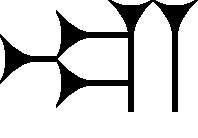
The cuneiform sign URU is a relatively distinctive sign in the cuneiform sign lists; with its two verticals at the sign's right, and the central long horizontal stroke, it is not easily confused with other signs. It is commonly found in the intrigues of the 14th century BC Amarna letters since the letters often concern city-state locations, or surrounding regions or cities/towns. URU is also used in the Epic of Gilgamesh. The cuneiform sign is almost exclusively used as a Sumerogram, and in the Akkadian language, it is the Akkadian for "ālu", city, or town. The usage of URU in the Epic of Gilgamesh is only for Sumerogram "URU",. All uses in the Epic for URU are for various spellings of ālu, and usually an added sign complement; there is one usage in the Epic of URU for the city Shuruppak: URU.Šu-ri-ip-pak,.

The cuneiform mi, sign is a distinctive sign in the wedge-stroke group, and is used as a syllabic for mi, me, and an alphabetic for m, i, or e; it is also a Sumerogram for MI, used for Akkadian language, "mūšu", night. MI, in the Epic of Gilgamesh, is used in (Chapters) Tablets I, II, III, and XII as either MI, or MI.MEŠ, a total of six times; other spellings of mūšu in other sections are alphabetic/syllabic, four times.

The cuneiform bi sign, also pí, and used for other syllabic forms, as well as a sumerogram, is a common use syllabic and alphabetic cuneiform sign used in both the mid-14th century BC Amarna letters and the Epic of Gilgamesh. In the Amarna letters, it is sometimes used for the spelling of the archers, 'pí-t(x)-t(x)', an often requested need from the Pharaoh in the vassal state sub-corpus of the letters.
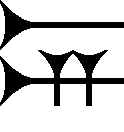
The cuneiform sign ni is a common-use sign of the Amarna letters, the Epic of Gilgamesh, and other cuneiform texts. It has a secondary sub-use in the Amarna letters for addressing the Pharaoh, from the vassal states of Canaan. The address to the Pharaoh is often 'King-Lord-Mine': LUGAL, EN-ia which has many varieties of expression. "LUGAL" is Akkadian language for "Šarru", English "king", and EN in Akkadian is bēlu, for "Lord",. In some Amarna letters the sub-use of ni is lí, for spelling "bēlu", be-lí often .

The cuneiform sign ši, lim, and Sumerogram IGI is a common-use sign of the Amarna letters, the Epic of Gilgamesh, and other cuneiform texts. As the syllabic form it is commonly used for ši, lim/lem, and for Sumerograms, it is most commonly used for IGI, and "before". Also, for ši and lim/lem it can be used syllabically for š, i, l, i/e, and m, in the spelling of words.

The cuneiform giš sign,, is a common, multi-use sign, in the Epic of Gilgamesh, the Amarna letters, and other cuneiform texts. It also has a major usage as a sumerogram, GIŠ, for English language "wood", and is used as a determinative at the beginning of words, for items made of wood. The 12 Chapters (Tablets) of the Epic of Gilgamesh lists 16 named items beginning with "GIŠ".

The cuneiform di sign, also de, ṭe, ṭi, and sumerograms DI and SÁ is a common-use sign of the Epic of Gilgamesh, the 1350 BC Amarna letters, and other cuneiform texts. In the Akkadian language for forming words, it can be used syllabically for: de, di, ṭe, and ṭi; also alphabetically for letters d, ṭ, e, or i. Some consonant-pairs (d/t), are also interchangeable.

The cuneiform sign id, also it, and with other sub-uses, including a sumerogram, Á, for Akkadian language idû,, is a common-use sign in the Epic of Gilgamesh, the Amarna letters, and other cuneiform texts. Letters ("d/t") are paired consonants in the Akkadian language ('voiced'/'unvoiced'), thus the other sub-uses of the sign are for ed, et, eṭ, and iṭ. Cuneiform id/it can be a syllabic for ed, et, eṭ, id, it, and iṭ, or an alphabetic for any of the constructs thereof. It is also has a sub-use for á, as well as the sumerogram for Á.
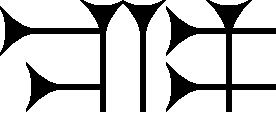
The cuneiform ta sign is a common, multi-use sign of the Epic of Gilgamesh, the 1350 BC Amarna letters, and other cuneiform texts. It also has a sumerogrammic usage for TA, for example in the Epic of Gilgamesh, for Akkadian language "ultu", English language for from, or since, but in only (1) location in the 12 tablet Epic of Gilgamesh. Sumerogram TA is used elsewhere in the Epic, (7) more times.

















